Hyperdimension Neptunia Victory Review
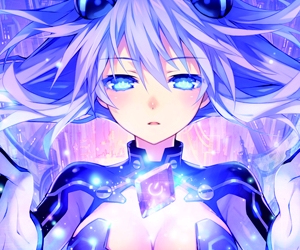 Game: Hyperdimension Neptunia Victory
Game: Hyperdimension Neptunia Victory
Developer: CompileHert, Idea Factory
Publisher: NIS America
Available on: PlayStation 3 only
The Hyperdimension Neptunia series of JRPGs has a unique meta-fictional concept ambitious enough to make it worthy of attention despite the frequent misgivings of (Western) reviewers: its wholly female cast are anthropomorphised versions of real-world gaming hardware. The original game, Hyperdimension Neptunia, was a dizzying metaphorical take on the current console war set in the world of Gameindustri. If you’re new to the series, take a moment to marvel at that peerless piece of localisation.
Hyperdimension Neptunia pitted the three goddesses (or “CPUs”) of worlds representing the Xbox 360, PlayStation 3 and Wii (“Leanbox”, “Lastation” and “Lowee”, respectively) against each other while the protagonist, Neptune, CPU of “Planeptune” (the never-released SEGA Neptune) sought to regain her lost memories. The sequel used the younger sisters of those goddesses to tell the story of handheld consoles, while this third game is set in the 1980s.
Reviews of the earlier games may have expressed disappointment that an interesting premise was let down by the over-sexualisation of shallow characters, but the series nevertheless remains popular among fans of visual-novel style JRPGs. Can Hyperdimension Neptunia Victory transcend the niche appeal of its forebears? Does it matter? Read on and find out…
STORY: Despite the fact that this game is set in the 1980s, the characters Noire (PlayStation), Vert (Xbox) and Blanc (Wii) from the previous games return. The decision to use these characters even though the first PlayStation and Xbox consoles weren’t released until 1994 and 2001 respectively means that the narrative must deviate significantly from the real-world struggles whose satire is arguably the series’ main selling point.
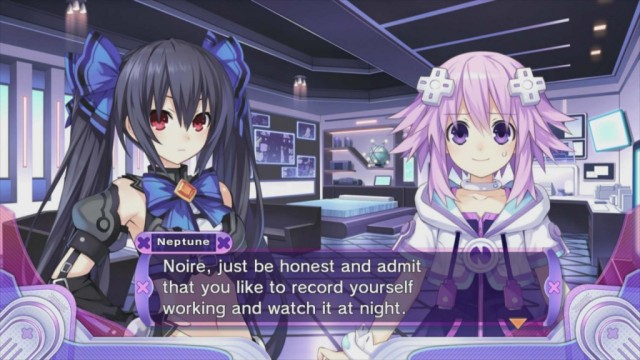
Instead, the characters, such as future Xbox Vert, an online gaming addict, represent almost embryonic versions of their respective consoles. This is an interesting idea, but it’s hard not to wonder if it might have been more interesting to use characters that represented 1980s consoles instead rather than re-use the existing cast in slightly different roles.
Our heroine is once again the responsibility-shy Neptune, only this time, she’s hurled into a universe where not only is she is no longer the CPU of Planeptune (ousted by ditzy Mega Drive avatar Plutia), but none of the other characters know who she is. She attempts to unravel the scenario and put things right, and in doing so discovers a plot by a mysterious organisation known as the Seven Sages to upset the faith that the countries have in their CPUs. The way the Seven Sages attempt to undermine the almost divine authority wielded by the CPUs recalls the eternal battle that the industry fights against the threat of piracy.
It is not strictly necessary to have played either of the preceding games in order to follow the plot, but the setting is potentially very confusing for those without a grounding in the series’ mythology. The delivery of the narrative, mainly through scrollable text boxes during dialogue sections known as “events”, also risks alienating newcomers. Do not believe the trailer‘s boast that “every event oozes with interesting info,” for while every event is certainly wordy, rarely do those words contain any actual “info”, interesting or otherwise. The trailer goes on to claim that “you’ll lose track of time if you’re not careful!”, but it would be more accurate to admit that unless you don’t mind spending hours reading utterly interminable babble for the sake of spotting the well-hidden nuggets of content and wit (mainly in the form of gaming in-jokes), you will certainly lose track of the plot.
It’s also worth mentioning that unless you fast-forward through them, “events” will take up an enormous proportion of the time you spend playing this game. JRPG fans have never been opposed to excessively wordy cutscenes, but the sheer volume of text in this game will try the patience of all but the most dedicated fans of this cheerful anime aesthetic.
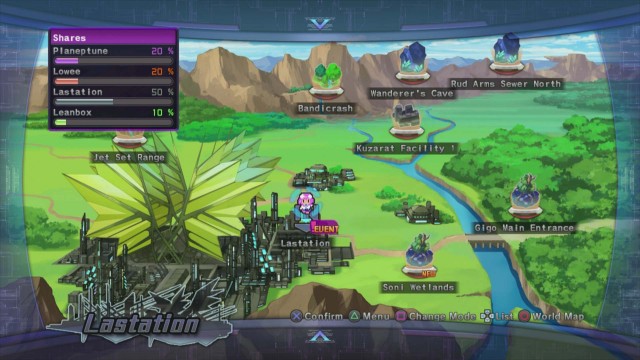
GRAPHICS: There are aspects to Hyperdimension Neptunia Victory’s design that are worthy of analysis and praise, but it will save time and energy if we get the boobs out of the way first. They bulge out of the girls’ fetishistic outfits in two-dimensional renderings, they are discussed at great length (breadth?) during dialogue and they are thrust in three eye-popping dimensions towards the screen as the characters assume their powerful “HDD” forms in battle. They are huge, unavoidable, and they are as much a feature of this series as blood is to Tarantino movies so if they make you uncomfortable for either ideological or aesthetic reasons, I can only suggest you do not play this game.
That aside, Hyperdimension Neptunia Victory’s visuals are interesting. The late eighties gaming theme is cleverly reflected in the map screens, which bear a deliberate, colourful resemblance to the world maps of classic adventure games. The city screens are just as cute, with sprite-like representations of the characters populating their streets. Still more impressive is the way in which the personalities and design of the real-life hardware informs the design of the environments and characters. The characters’ clothing and accessories play homage to the motifs of their consoles while the environments are inspired by their overall appearance: Lowee is as white and angular as the Wii, Lastation reflects the monolithic black of the PlayStation’s later incarnations and Leanbox reflects the green-accented utilitarianism of the Xbox.
The two-dimensional drawings that accompany the dialogue are beautifully drawn but unfortunately, the three-dimensional graphics that display the actual gameplay look dated. Although the actual design of the cities is well-thought through, the execution is lacking. Textures are flat and environments, while consistent, are a little featureless. Enemy design is uninspired and the three-dimensional versions of the girls lose something in their transition from two. The special move animations improve things a little but overall the gameplay appears lacklustre in comparison to the events and (embarrassingly) the menu screens.
SOUND: Much of the game’s music is performed by the Earthbound Papas, a band founded by none other than Nobuo Uematsu, but don’t expect a Final Fantasy-style atmospheric score. Instead, prepare for hours of tinny, sugary J-Pop. It’s not a bad example of the genre, but that genre is an acquired taste so if you haven’t developed that taste, you will find the soundtrack grating. The English voiceovers are pretty good, or at least no less squeaky than the Japanese, but you won’t like either dub if you’re not a fan of high-pitched anime dialogue.
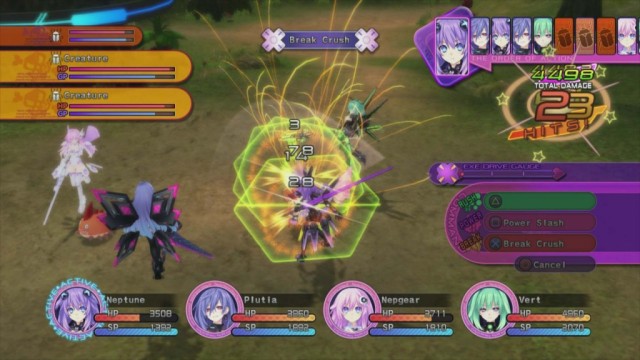
GAMEPLAY: Despite a strikingly original premise, Hyperdimension Neptunia Victory’s gameplay is fairly pedestrian. You’ll wander through dungeons fighting monsters in turn-based tactical battles, transforming your characters into their “HDD” forms, in which they become armour-clad dominatrices who perform special moves for increased damage. You’re assigned “Quests”, which for the most part are simple mark-missions in which you need to slay a certain number of a certain type of monster before returning to base and collecting your reward. There’s a huge proportion of grind to progression, but it’s fairly breezy grind made more bearable by a relentless reward loop that grants characters XP for just about everything: leading the party, jumping, and even walking around.
Characters can move freely within a certain area in battles, and the area in which their attack is effective is represented by a blue square in front of them. In many cases characters can position themselves so they’re able to hit more than one enemy, but this involves awkward maneuvering using the twitchy analogue sticks. The challenge from tactical battles should come from figuring out a strategy, not from navigating fiddly controls, but Hyperdimension Neptunia Victory relies too much on the latter for comfort.
Strategy is present, but it doesn’t show up for the first few hours of play, once your characters have learned several skills and you need to think about how to configure them before battle and when to deploy them within it. Before then (and indeed for most generic monster battles throughout the game), it’s a case of whittling down enemies’ guard before launching an all-out attack, much like the stagger system in Final Fantasy XIII but without that game’s smooth, tactical, semi-automation. Bosses fare better but still rely more on a high-powered loadout and over-levelled characters than the decisions you make during the fight itself.
Since much of the appeal of this game is the art style and attire of the characters, it’s appropriate that there are so many character customisation options. Rewards can be spent on a mind-boggling wardrobe for each of the girls and outfits affect stats; the focus is on form, not function. Outfits are incredibly detailed and you’ll be able to mix-and-match a vast number of garments and accessories. Clothing is pleasingly expensive, meaning that each item feels like a a real reward for hard work. If you’re reading this and thinking that this entire mechanic sounds like meaningless busywork, this game is not for you.
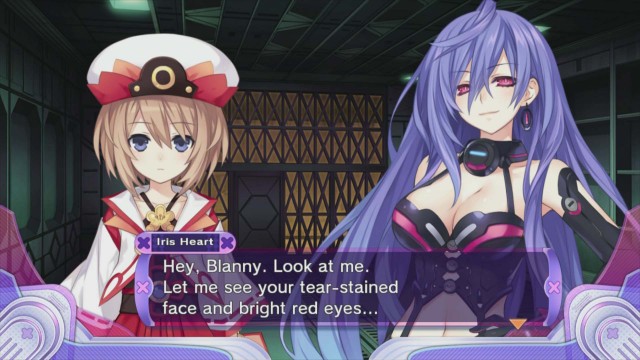
LONGEVITY: You get out of Hyperdimension Neptunia Victory what you put in. If you don’t skip through the events, and if you complete all the quests in order to unlock the best equipment (and the most… alluring… outfits), you can probably double the time you spend with the game than if you whiz through everything. The game’s long-winded presentation makes it value for money in the sense that it will take you many, many hours to dutifully sit through all its content, but an unusually small proportion of that time will actually be spent playing.
VERDICT: It’s very simple really: if you liked the previous Hyperdimension Neptunia games or you frequently use the terms “Moe” or “Loli” when discussing your favourite things, you’ll probably like this. Everyone else should probably move along; the rambling dialogue, unremarkable combat and saccharine aesthetic will simply prove too much. This is not a terrible game, but in its reduction of an interesting premise to overly-cute anime tropes and a selection of ever-more revealing outfits, it’s clear that it values style far above substance.





